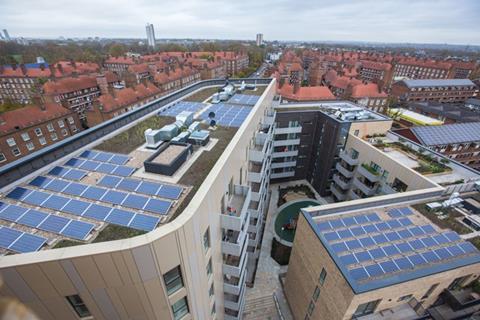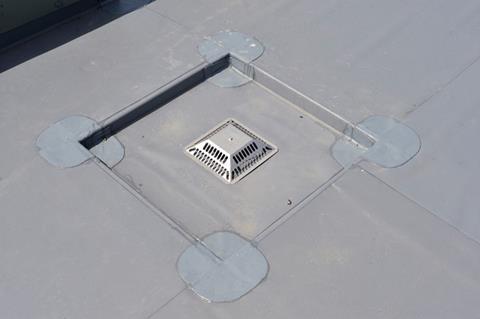The correct design of rainwater outlets is a vital factor in the success or failure of a flat roof. This CPD outlines the key considerations. It is sponsored by Fixfast

How to take this module
UBM’s CPD distance-learning programme is open to anyone seeking to develop their knowledge and skills. Each module also offers members of professional institutions an opportunity to earn between 30 and 90 minutes of credits towards their annual CPD requirement.
This article is accredited by the CPD Certification Service. To earn CPD credits, read the article and then click the link below to complete your details and answer the questions. You will receive your results instantly, and if all the questions are correctly answered, you will be able to download your CPD certificate straight away.
CPD CREDITS: 60 MINUTES
DEADLINE: 13 MAY 2016

INTRODUCTION
Efficient water management is critical to the longevity of a building. Rainfall onto flat roofs needs to be correctly managed to protect the structure against ingress of water, but the consideration and design of rainwater outlets is often left too late in the design process. It is common practice to defer it to the roofing contractor to address at a far later stage of the specification.
This CPD shows how the choice and specification of the roof structure and its finishes can make a significant impact on the capacity required for surface water drainage.
REGULATIONS AND STANDARDS
Rainwater drainage is covered by �ڶ����� Regulations Part H3. Approved Document H makes basic provisions for adequate disposal of rainwater from roofs and paved areas, minimising the risk of blockages or leakage and ensuring access is provided for maintenance.
Rainwater calculations are carried out in accordance with BS EN 12056-3:2000, and the National Annex for the UK. The level of rainfall that a given roof drainage system should be able to cope with is based on the potential use of the building, its projected lifespan and its geographical location. The level of protection is then calculated according to the risk of any overflow entering the building, and the consequences of damage to the fabric and internal processes.
NHBC Standard 7.1 requires flat roofs and balconies to include an overflow as a precaution against a blocked outlet. This can be an additional outlet or chute and must have at least the same capacity as the original outlet or outlets.


CALCULATION FACTORS
Rainfall intensity
The rate at which rain lands is known as rainfall intensity, and this forms the basis of rainwater outlet design. The unit of rainfall intensity is litres per second per square metre (l/s/m2).
Under BS EN 12056, the design must be assessed against the time it takes for a peak summer downpour of two minutes’ duration to run off roof surfaces into outlets. The frequency and severity of rainfall is related to geographic location, and the meteorological data for the UK is given in the National Annex to BS EN 12056. Although upland areas of northern and western Britain have higher average rainfalls, the greatest intensity of summer rain occurs in south-east England.

The attenuation effect
When water falls on a roof it is channelled in a particular direction – this is the “collection” stage. This is effected by means of falls built into the roof structure, deck or tapered insulation schemes, from a series of high points down to valley gutters, sumps or eaves gutters. The water is then removed from the roof area via the drainage outlets. For a flat, inverted or green roof, the discharge capacities can be up to a third less than a traditional roof with a fall of 1:60 or more. This is because of what’s known as the attenuation effect: rain falling on the most remote areas of a given catchment will take longer to drain across or through the surface for the duration of the two-minute downpour that is used as the basis for design. The water stays on the roof for longer and therefore fewer outlets are required to cope with peak flows.
Type of outlet
The type of outlet will also affect the number that are required. Horizontal or parapet type outlets act like a weir, and therefore flow rates are much lower than with vertical or sump type drains. Because they provide only up to one-third of the flow, about three times as many horizontal or parapet type outlets may be needed. This means that the architect should consider the location of vertical rainwater pipes early in the concept design, as well as whether to use internal vertical outlets, and how to get bends and pipes out through the ceiling void to avoid internal drops.
Vertical surfaces
Another factor that is often ignored is the run-off from vertical surfaces or facades above and adjoining a flat roof. BS EN 12056 requires that 50% of the vertical surface, up to a maximum height of 10m from the roof, be included in the roof area to be drained. On buildings where there are multiple roof areas which drain on to each other sequentially, the cumulative flow totals must be taken into account not only at concept design stage but in calculations for the final outlets and downpipes from the lowest areas.
Return periods
A return period is the likelihood of a storm of a similar intensity returning within that period of time. So what return period should designers accommodate? BS EN 12056 gives four categories of risk, as follows:
- Category 1 All completely flat roofs, and roofs where ponding can be tolerated, are designed using a one-year return period. This includes cases where the building has no parapet or upstand, as long as any overflow can fall clear of the building, and the roof structure can cope with the additional live loading. Surcharge and overflow flooding will only occur in very heavy rain, and are therefore not normally a problem.
- Category 2 Any flat roof laid to significant falls, where ponding depths will become excessive if the rainwater system fails to cope, should be designed for an intensity based on the building life and a suitable factor of safety. For most buildings, a 60-year life and safety factor of 1.5 would be the most common values chosen used the absence of other information. This equates to a return period of 90 years.
- Category 3 When a higher degree of security is desired than that provided by category 2, a return period of 4.5 x the anticipated building life is used. For a building with a 60-year life, this would equate to a return period of 270 years.
- Category 4 This category simply refers to “maximum probable rainfall” with no defined period. It is used when there should be the highest possible security – for example, at a nuclear facility. There is a separate rainfall map for this category.


LAYOUT AND SPECIFICATION
Positioning
The architect should set the positions of outlets and vertical rainwater pipes early in the concept design. Sometimes the appearance and location of downpipes is a material consideration in obtaining planning permission.
At the detailed engineering stage of the design and specification, if the calculation indicates the provisional capacity is not sufficient, there are three possible solutions:
- Change to higher performance outlet systems, thereby allowing a greater flow
- Increase the depth of the sump in which the outlet is located; this can include a gutter
- Add extra outlet positions.
The last option is the one that invariably creates tensions at later stages, especially if the below-ground drainage configuration has already been agreed or built.
Materials
Choice of material for the body and spigot of an outlet is important and must reflect the required longevity of the building. Stainless steel is probably the most durable component material, although it is more expensive than uPVC.
Watertightness
When using flat roof outlets in either new-build or refurbishment applications, it is critical to ensure that the seal is fail-safe. In refurbishment applications, the stem of the outlet is inserted inside the existing pipework and the seal at the base of the outlet ensures that the area is protected from water back-up.
Water back-up takes place when a blockage occurs within the main drainage pipework of the building. From the blockage, the water backs Above: At Greenwich Millennium Village (top) and the Pembury Circus residential development (below), both in London, Fixfast provided rainwater outlets suitable for a single-ply membrane roof and one comprising green and shingled areas up the pipe until it reaches the point where the outlet has been installed. The seal on the outlet provides a watertight connection at this critical point, which in a retrofit situation can be difficult to achieve.
Outlets also need to be effectively sealed to the waterproofing layer, or membrane. One-piece units allow quick installation and are factory-bonded to a compatible flange material, which allows the roofing contractor to make an impenetrable seal against water ingress.
Traditionally, outlets pass horizontally through a parapet or upstand, and discharge into a hopper, which collects the rainwater into a vertical external downpipe. Vertical outlets with internal rainwater pipes must maintain the seal of the vapour control layer (VCL) and be insulated to eliminate condensation on the cold pipework during winter months. Dual-flange outlets include a secondary lower membrane seal to the VCL, which has a further installation benefit of allowing early water sealing of the deck prior to insulation and final waterproofing.
Leaf guards
Leaf guards should be considered in calculating flow rates. Ideally, they should be designed to be self-clearing of windblown leaves or debris, with apertures sufficiently large to allow peak flows without risk of internal blockages. Guards should be removable and tamper-proof, and may need to be low profile if in a pedestrianised area to avoid becoming a trip hazard.

BUILDING INFORMATION MODELLING
BIM enables designers to relate the physical data of building components to the holistic building model. This ensures that when revisions are made to the model, related elements can be updated or reconsidered within the parameters of the objects selected. In terms of rainwater outlets, an obvious use of BIM is to link data on maximum rainwater catchment for a roof area to the group of outlets serving that area – if the run-off strategy is configured differently to the model’s recommendation, the designer can be alerted to check the rainwater design.
Using BIM will ensure that correct disposal of surface water from the building envelope is addressed from concept to implementation.

How to take this module
UBM’s CPD distance-learning programme is open to anyone seeking to develop their knowledge and skills. Each module also offers members of professional institutions an opportunity to earn between 30 and 90 minutes of credits towards their annual CPD requirement.
This article is accredited by the CPD Certification Service. To earn CPD credits, read the article and then click the link below to complete your details and answer the questions. You will receive your results instantly, and if all the questions are correctly answered, you will be able to download your CPD certificate straight away.
CPD CREDITS: 60 MINUTES
DEADLINE: 13 MAY 2016
Privacy policy
Information you supply to UBM Information Ltd may be used for publication and also to provide you with information about our products or services in the form of direct marketing by email, telephone, fax or post. Information may also be made available to third parties. UBM Information Ltd may send updates about �ڶ����� CPD and other relevant UBM products and services. By providing your email address you consent to being contacted by email by UBM Information Ltd or other third parties. If at any time you no longer wish to receive anything from UBM Information Ltd or to have your data made available to third parties, contact the Data Protection Coordinator, UBM Information Ltd, FREEPOST LON 15637, Tonbridge, TN9 1BR, Freephone 0800 279 0357 or email ubmidpa@ubm.com. View our full privacy policy at




















No comments yet